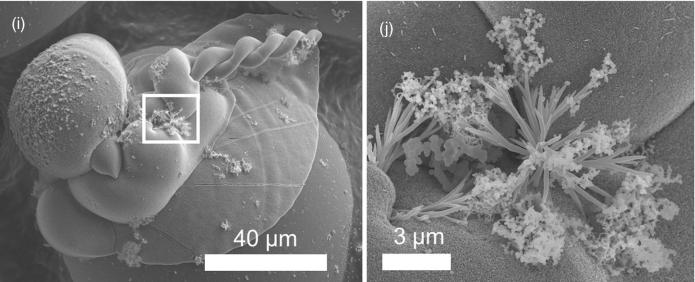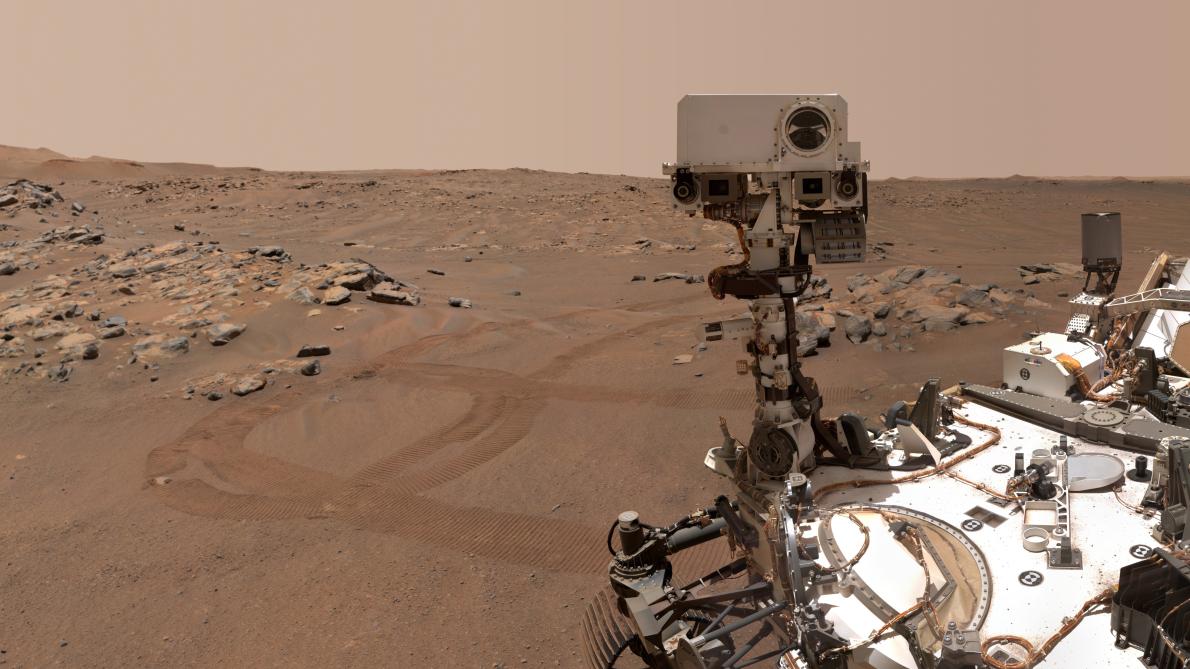There’s nothing easy about searching for evidence of life on Mars. Not only do we somehow have to land a rover there, which is extraordinarily difficult. But the rover needs the right instruments, and it has to search in the right location. Right now, the Perseverance lander has checked those boxes as it pursues its mission in Jezero Crater.
But there’s another problem: there are structures that look like fossils but aren’t. Many natural chemical processes produce structures that mimic biological ones. How can we tell them apart? How can we prepare for these false positives?
Scientists know of dozens of natural processes that can create organic-looking structures. And there are likely many more that haven’t been discovered yet. Some of the microscopic structures are very beguiling and have fooled scientists before.
In a new article, a pair of researchers outline some of the problems with false fossils in the search for real microscopic fossils on Mars. The article is titled “False Biosignatures on Mars: Anticipating Ambiguity.” It’s published in the Journal of the Geological Society.
No article about false indications of life on Mars would be complete without mentioning the Allan Hills 84001 meteorite that was discovered in Antarctica in 1984. That Martian meteorite is very old—about four billion years old—which is when scientists think Mars was briefly habitable.
The microscopic structures in the Allan Hills meteorite have a distinct biological appearance. They’re only 20 – 100 nanometers in length, which is the size that theoretical nanobacteria would be. However, they’re smaller than any known lifeform, and since then, scientists have discarded the idea that nanobacteria exist.
“We have been fooled by life-mimicking processes in the past.”
Dr. Julie Cosmidis, article co-author, Oxford.
The structures in the meteorite attracted quite a bit of attention, and the affair dragged on for a few years. But eventually, the scientific community moved on, realizing that morphology alone can’t be used to detect primitive life.

The Allan Hills meteorite affair has faded, but it’s still significant and is kind of a teaching moment for all of us. False starts like it inspired the authors of the new paper to take a harder look at abiotic origins for organic-appearing structures.
“We have been fooled by life-mimicking processes in the past,” article co-author Dr. Julie Cosmidis said in a press release. “On many occasions, objects that looked like fossil microbes were described in ancient rocks on Earth and even in meteorites from Mars, but after deeper examination, they turned out to have non-biological origins. This article is a cautionary tale in which we call for further research on life-mimicking processes in the context of Mars so that we avoid falling into the same traps over and over again.”
The authors point out that anything Perseverance finds on Mars that looks like a fossil is likely to have very ambiguous origins. If Perseverance does find something, news of the “discovery” will spread rapidly. But caution is required, and ideally, scientists will get in front of any rapidly-spreading conclusions about fossilized life on Mars. How can they do that?
Cosmidis and her co-author Dr. Sean McMahon, from the University of Edinburgh, say that an interdisciplinary effort is needed to “… shed more light on how lifelike deposits could form on Mars.”
“At some stage, a Mars rover will almost certainly find something that looks a lot like a fossil, so being able to confidently distinguish these from structures and substances made by chemical reactions is vital,” McMahon said. “For every type of fossil out there, there is at least one non-biological process that creates very similar things, so there is a real need to improve our understanding of how these form.”

Chemical gardens are life-like structures produced purely through non-biological chemical processes. The structures are particularly beguiling because many of them do look nearly identical to actual microscopic fossils. Also, both chemical gardens and actual fossils can be found in the same types and ages of rock.
“Many of these are probably fossils – indeed, fossils from a deep biosphere hosted in igneous rocks, with special relevance to some scenarios for life on Mars – but some are probably not and may result from chemical-garden-like processes and/or other types of self-organization that lead to filamentous crystals and aggregates,” the authors write.
Carbonate-silica biomorphs are another type of abiotic structure that looks like they have biological origins. “Although purely inorganic, the curved and sinuous shapes of the biomorphs evoke biological objects, such as helical and segmented filamentous microbes, protists and even plants and animals,” the authors write. They’re formed from alkali Earth metals and look stunningly organic. Scientists divide them into three classes: helicoidal filaments, worm-like braids, and leaf-like flat sheets.

Then there are carbon-sulphur biomorphs. They also appear shockingly biological in origin and form spheres and both straight and helical filaments. The authors of a 2016 paper on carbon-sulphur biomorphs said, “The morphology and composition of these carbon/sulphur microstructures so closely resemble microbial cellular and extracellular structures that new caution must be applied to the interpretation of putative microbial biosignatures in the fossil record.”

C. Nims (University of Michigan) ( parts d and e).
Human history in some ways is one long tale of misunderstanding nature, at least until we devised the scientific method. So it’s not shocking that we’re still struggling with it. In their conclusion, the authors point out how difficult it is to conclude that something is a fossil.
The images make it clear that abiotic processes can produce structures that appear very life-like. But what makes detection even more difficult is that these biomorphs mimic biotic structures in other ways besides just morphology.
“First, abiotic processes can mimic not only morphological biosignatures but also chemical/molecular, mineralogical, isotopic and textural biosignatures; a critical attitude is required in all cases and morphological data are not necessarily less reliable than other possible lines of evidence for life,” they explain. So multiple lines of evidence can suggest biological origins where there are none.
Maybe we’ll get lucky and Perseverance rover or some other mission will uncover undeniable evidence of ancient Martian life. But it’s more likely that we face a series of false positives. “Because life itself is presumed to be the product of self-organization in abiotic geochemical reactions, the complexity of abiotic natural products should not be underestimated,” they point out.
A lot of work has gone into the study of false biosignatures, and the authors think more is required. According to McMahon and Cosmidis, more interdisciplinary work is needed. The key is to build up a rich dataset for false positives in the same manner that we’ve built one up for biosignatures. They suggest that field experiments in Mars-analogue locations, as well as laboratory work, can get us there.
They’re confident it can be done.
“Nevertheless, we are optimistic that the problem of false biosignatures is not intractable. The better these phenomena are understood, the more sensitively we will be able to discriminate between true evidence of life and these impostors.”
More:
- Press Release: Life on Mars search could be misled by false fossils
- Research Article: False biosignatures on Mars: anticipating ambiguity
- Universe Today: Confirmed. Fossils That Formed 3.5 billion Years Ago, Really are Fossils. The Oldest Evidence of Life Found So Far


There is practically no known microfossil that haven’t abiotic confounds (currently bacterial pores etched in volcanic glasses may be an exception) so listed methods tries to test for them. With that context one can see the need for working up more extensive datasets of possible confounds.
Regarding AH 84001 the morphologies were what draw the initially large media interest. But scientifically there were more observations of putative biological significance than the morphologies, such as potentially habitable conditions and trace fossil candidates, which is why the interest lasted a few years. But if you followed the paper trail (which I did at the time) what happened was that those observations were eventually shown to have no biological significance.